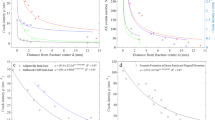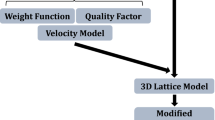Abstract
Recent advances in the theory of fracture and fragmentation are reviewed. Empirical laws in seismology are interpreted from a fractal perspective, and earthquakes are viewed as a self-organized critical phenomenon (SOC). Earthquakes occur as an energy dissipation process in the earth's crust to which the tectonic energy is continuously input. The crust self-organizes into the critical state and the temporal and spatial fractal structure emerges naturally. Power-law relations known in seismology are the expression of the critical state of the crust. An SOC model for earthquakes, which explains the Gutenberg-Richter relation, the Omori's formula of aftershocks and the fractal distribution of hypocenters, is presented. A new view of earthquake phenomena shares a common standpoint with other disciplines to study natural complex phenomena with a unified theory.
Similar content being viewed by others
References
Aki, K. (1979),Characterization of Barriers on an Earthquake Fault, J. Geophys. Res.84, 6140–6148.
Aki, K.,A probabilistic synthesis of precursory phenomena. InEarthquake Prediction: An International Review, M. Ewing Ser., vol. 4 (eds. Simpson, D. W., and Richards, P. G.) (AGU, Washington, D. C. 1981) pp. 566–574.
Allegre, C. J., Le Mouel, andProvost, A. (1982),Scaling Rules in Rock Fracture and Possible Implications for Earthquake Prediction, Nature297, 47–49.
Atmanspacher, H., Schneingraber, H., andWiedenmann, G. (1989),Determination of f(α) for a Limited Random Point Set, Phys. Rev.A40, 3954–3963.
Bak, P., andTang, C. (1989),Earthquakes as a Self-organized Critical Phenomenon, J. Geophys. Res.94, 15,635–15,637.
Bak, P., Tang, C., andWiesenfeld, K. (1987),Self-organized Criticality: An Explanation of 1/f Noise, Phys. Rev. Lett.59, 381–384.
Bak, P., Tang, C., andWiesenfeld, K. (1988),Self-organized Criticality, Phys. Rev.A38, 364–371.
Bak, P., Chen, K., andCreutz, M. (1989),Self-organized Criticality in the ‘Game of Life’, Nature342, 780–782.
Bebbington, M., Vere-Jones, D., andZheng, X. (1990),Percolation Theory: A Model for Rock Fracture? Geophys. J. Int.100, 215–220.
Burridge, R., andKnopoff, L. (1967),Model and Theoretical Seismicity, Bull. Seismol. Soc. Am.57, 341–371.
Carlson, J. M., andLanger, J. S. (1989),Properties of Earthquakes Generated by Fault Dynamics, Phys. Rev. Lett.62, 2632–2635.
Chen, K., Bak, P., andObukhov, S. P. (1991),Self-organized Criticality in Crack-progagation Model of Earthquakes, Phys. Rev.A43, 625–630.
Dhar, D., andRamaswamy, R. (1989),Exactly Solved Model of Self-organized Critical Phenomena, Phys. Rev. Lett.63, 1659–1662.
Durrett, R. (1988),Crabgrass, Measles, and Gypsy Moths: An Introduction to Interacting Particle Systems, Mathemat. Intelligence10, 37–47.
Enya, O. (1901),On Aftershocks, Rep. Earthq. Inv. Comm.35, 35–56 (in Japanese).
Gardner, M. (1970),Mathematical Games Sci. Am.223 (10), 120–123.
Geilikman, M. B., Golubeva, T. V., andPisarenko, V. F. (1990),Multifractal Patterns of Seismicity, Earth Planet. Sci. Lett.99, 127–132.
Glansdorff, P., andPrigogine, I.,Theory of Structure Stability and Fluctuations (Wiley and Sons, London 1971).
Griffith, A. A. (1921),The Phenomena of Rupture and Flow in Solids, Phil. Trans. R. Soc.A221, 163–198.
Griffith, A. A. (1924),The Theory of Rupture, Proc. Ist Intern. Cong. Appl. Mech., Delft, pp. 55–63.
Haken, H.,Synergetics: Nonequilibrium Phase Transitions and Self-organization in Physics, Chemistry and Biology (Springer, Berlin 1977).
Haken, H.,Advanced Synergetics (Springer, Berlin 1983).
Halsey, T. C., Jensen, M. H., Kadanoff, L. P., Procaccia, I., andShraiman, B. I. (1986),Fractal Measures and their Singularities: The Characterization of Strange sets, Phys. Rev.A33, 1141–1151.
Haskell, N. A. (1969),Elastic Displacements in the Near Field of a Propagating Fault, Bull. Seismol. Soc. Am.59, 865–908.
Herrmann, H. J., andRoux, S., eds.,Statistical Models for the Fracture of Disordered Media (Elsevier, Amsterdam 1990).
Herrmann, H. J.,Fractures. InFractals and Disordered Systems (eds. Bunde, A., and Havlin, S.) (Springer-Verlag, 1991) pp. 175–205.
Hirabayashi, T., andIto, K. (1990),Multifractal Analysis of Earthquakes, Pure and Appl. Geophys., this issue.
Hirata, T. (1987),Omori's Power Law Aftershock Sequences of Microfracturing in Rock Fracturing Experiment, J. Geophys. Res.92, 6215–6221.
Hirata, T., andImoto, M. (1991),Multifractal Analysis of Spatial Distribution of Microearthquakes in the Kanto Region, Geophys. J. Int.107, 155–162.
Hirata, T., Satoh, T., andIto, K. (1987),Fractal Structure of Spatial Distribution of Microfracturing in Rock, Geophys. J. R. Astr. Soc.67, 697–717.
Hwa, T., andKardar, M. (1989),Fractals and Self-organized Criticality in Dissipative Dynamics, PhysicaD38, 198–202.
Ishimoto, M., andIida, K. (1939),Observations sur les seisms energistré par le microseismograph construite dernierment (I), Bull. Earthq. Res. Inst.17, 443–478 (in Japanese).
Ito, K., andMatsuzaki, M. (1990),Earthquakes as Self-organized Critical Phenomena, J. Geophys. Res.95, 6853–6860.
Jensen, M. H., Kadanoff, K., Libchaber, A., Procaccia, I., andStavans, J. (1985),Global Universality at the Onset of Chaos: Results of a Forced Rayleigh-Benard Experiment, Phys. Rev. Lett.55, 2798–2801.
Kagan, Y. Y. (1981),Spatial Distribution of Earthquakes: The Three-point Moment Function, Geophys. J. R. Astr. Soc.67, 697–717.
Kagan, Y. Y., andKnopoff, L. (1980),Spatial Distribution of Earthquakes: The Two-point Correlation Function, Geophys. J. R. Astr. Soc.62, 697–717.
Kanamori, H., andAnderson, D. L. (1975),Theoretical Basis of Some Empirical Relations in Seismology, Bull. Seismol. Soc. Am.65, 1073–1095.
King, G. (1983),The Accommodation of Large Strains in the Upper Lithosphere of the Earth and Other Solids by Self-similar Fault Systems: The Geometrical Origin of b-values, Pure and Appl. Geophys.121, 761–815.
Kinzel, W.,Directed percolation. InPercolation Structures and Processes (ed. Weil, R.) (Adam Hilger, Bristol 1983) pp. 425–445.
Leath, P. L. (1976),Cluster Size and Boundary Distribution near Percolation Threshold, Phys. Rev.B14, 5046–5055.
Liggett, T. M.,Interacting Particle Systems (Springer-Verlag, New York 1985).
Lomnitz-Adler, J., andLemus-Diaz, P. (1989),A Stochastic Model for Fracture Growth on a Heterogeneous Seismic Fault, Geophys. J. Int.99, 183–194.
Lorenz, E. N. (1963),Deterministic Nonperiodic Flow, J. Atmos. Sci.20, 130–141.
Louis, E., andGuinea, F. (1989),Fracture as a Growth Process, PhysicaD38, 235–241.
Mandelbrot, B. B. (1967),How Long is the Coast of Britain? Statistical Self-similarity and Fractional Dimension, Science155, 636–638.
Mandelbrot, B. B.,Fractals: Form, Chance and Dimension (Freeman, San Francisco 1977).
Mandelbrot, B. B.,The Fractal Geometry of Nature (Freeman, San Francisco 1982).
Matsuzaki, M., andTakayasu, H. (1991),Fractal Features of Earthquake Phenomenon and a Simple Mechanical Model, J. Geophys. Res.96, 19,925–19,931.
May, R. M. (1976),Simple Mathematical Models with Very Complicated Dynamics, Nature261, 459–467.
McCauley, J. L. (1990),Introduction to Multifractals in Dynamical Systems Theory and Fully Developed Fluid Turbulence, Phys. Reports189, 225–226.
Meakin, P. (1991),Models for Material Failure and Deformation, Science252, 226–234.
Meneveau, C., andSreenivasan, K. R.,The multifractal spectrum of the dissipation field in turbulent flows. InPhysics of Chaos and Systems Far from Equilibrium (eds. Van, Minh-Duong, and Nicolis, B.) (North-Holland, Amsterdam 1987).
Mori, Y., Kaneko, K., andWadati, M. (1991),Fracture Dynamics by Quenching. I. Crack Patterns, J. Phys. Soc. Japan,60, 1591–1599.
Naftaly, U., Schwartz, M., Aharony, A., andStauffer, D. (1991),The Granular Fracture Model for Rock Fragmentation, J. Phys.A24, L1175-L1184.
Nakanishi, H. (1991),Statistical Properties of the Cellular-automaton Model for Earthquakes, Phys. Rev.A43, 6613–6621.
Nicolis, G., andPrigogine, I.,Self-organization in Nonequilibrium Systems: From Dissipative Structures to Order through Fluctuations (Wiley, New York 1977).
Ogata, Y. (1988),Statistical Models for Earthquake Occurrences and Residual Analysis for Point Processes, J. Am. Stat. Assoc83 (401), 9–27.
Ogata, Y. (1989),Statistical Model for Standard Seismicity and Detection of Anomalies by Residual Analysis, Tectonophys.169, 159–174.
Omori, F. (1894),On Aftershocks of Earthquakes, J. Coll. Sci. Imp. Univ. Tokyo7, 111–200.
Otsuka, M. (1971),A Simulation of Earthquakes Occurrences, Part 1: A Mechanical Model, Jishin24, 13–25 (in Japanese).
Otsuka, M. (1972),A Chain-reaction-type Source Model as a Tool to Interpret the Magnitude-frequency Relation of Earthquakes, J. Phys. Earth20, 35–45.
Pasad, R. R., Meneveau, C., andSreenivasan, K. R. (1988),Multifractal Nature of the Dissipation Field of Passive Scalars in Fully Developed Turbulent Flows, Phys. Rev. Lett.61, 74–77.
Peebles, P. J. E.,Large-scale Structure of the Universe (Princeton Univ. Press, Princeton 1980).
Pfeuty, P., andTuolouse, G.,Introduction to the Renormalization Group and Critical Phenomena (John Wiley and Sons, 1977).
Pietronero, L., andTosatti, E. eds.,Fractals in Physics (North-Holland, Amsterdam 1986).
Rikitake, T. (1958),Oscillations of a System of Disk Dynamos, Proc. Cambridge Philos. Soc.54, 89–105.
Sadvskiy, M. A., Golubeva, T. V., Pisarenko, V. F., andShnirman, M. G. (1984),Characteristic Dimensions of Rock and Hierarchical Properties of Seismicity, Izv. Acad. Sci. USSR, Earth Phys. Engl. Transl.,20, 87–96.
Selinger, R. L. B., Wang, Z.-G., Gelbart, W. M., andBen-Shaul, A. (1991),Statistical-thermodynamic Approach to Fracture, Phys. Rev.A43, 4396–4400.
Skjertorp, A. T., andMeakin, P. (1988),Fracture in Microsphere Monolayers Studied by Experiment and Computer Simulation, Nature,335, 424–426.
Smalley, R. F., Turcotte, D. L., andSolla, S. A. (1985),A Renormalization Group Approach to the Stick-slip Behavior of Faults, J. Geophys. Res.90, 1894–1900.
Sornette, A., Davy, Ph., andSornette, D. (1990),Structuration of the Lithosphere in Plate Tectonics as a Self-organized Critical Phenomenon, J. Geophys. Res.95, 17,353–17,361.
Sornette, A., andSornette, D. (1989),Self-organized Criticality and Earthquakes, Europhys. Lett.9, 197–202.
Stanley, H. G.,Introduction to Phase Transitions and Critical Phenomena (Clarendon Press, Oxford 1971).
Stanley, H. E., andMeakin, P. (1988),Multifractal Phenomena in Physics and Chemistry, Nature335, 405–409.
Stauffer, D.,Introduction to Percolation Theory (Taylor and Francis, London 1985).
Stuketee, J. A. (1958),Some Geophysical Applications of the Elasticity Theory of Dislocations, Can. J. Phys.36, 1168–1198.
Takayasu, H.,Pattern formation of dendritic fractals in fracture and electric breakdown. InFractals in Physics (eds. Pietronero, L., and Tosatti, E.) (North-Holland, Amsterdam 1986) pp. 181–184.
Takayasu, H., Nishikawa, I., andTasaki, H. (1988),Power-law Distribution of Aggregation Systems with Injection, Phys. Rev.A37, 3110–3117.
Termonia, Y., andMeakin, P. (1986),Formation of Fractal Cracks in Kinetic Fracture Model, Nature320, 429–431.
Terada, T.,Scientific Papers by Torahiko Terada, Vols. 1–6 (Iwanami Syoten, Tokyo 1931).
Thom, R.,Structural Stability and Morphogenesis, (Benjamin, Reading, MA 1975).
Thompson, D'arcy W.,On Growth and Form, (Cambridge Univ. Press, Cambridge 1917).
Totsuji, H., andKihara, T. (1969),The Correlation Function for the Distribution of Galaxies, Publ. Astron. Soc. Japan21, 221–229.
Turcotte, D. L. (1986),A Fractal Model for Crustal Deformation, Tectonophys.132, 361–369.
Utsu, T. (1969),Aftershocks and Earthquake Statistics (I), J. Fac. Sci., Hokkaido Univ., ser. VII,3, 129–195.
Utsu, T. (1970),, J. Fac. Sci., Hokkaido Univ., ser. VII,3, 197–266.
Wiesenfeld, K., Tang, G., andBak, P. (1989),A Physicist's Sandbox, J. Statist. Phys.54, 1441–1458.
Yamashina, K. (1978),Induced Earthquakes in the Izu-Peninsula by the Izu-Hanto-Oki Earthquake of 1974, Japan, Tectonophys.51, 139–154.
Zeeman, E. C.,Catastrophe Theory (Addison-Wesley, Reading, MA 1977).
Zhang, Yi-C. (1989).Scaling Theory of Self-organized Criticality, Phys. Rev. Lett.,63, 470–473.
Author information
Authors and Affiliations
Rights and permissions
About this article
Cite this article
Ito, K. Towards a new view of earthquake phenomena. PAGEOPH 138, 531–548 (1992). https://doi.org/10.1007/BF00876337
Accepted:
Issue Date:
DOI: https://doi.org/10.1007/BF00876337




